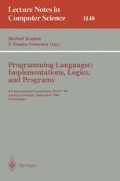Abstract
Homomorphisms are functions that match the divide-and-conquer paradigm and thus can be computed in parallel. Two problems are studied for homomorphisms on lists: (1) parallelism extraction: finding a homomorphic representation of a given function; (2) parallelism implementation: deriving an efficient parallel program that computes the function. A systematic approach to parallelism extraction proceeds by generalization of two sequential representations based on traditional cons lists and dual snoc lists. For some non-homomorphic functions, e.g., the maximum segment sum problem, our method provides an embedding into a homomorphism. The implementation is addressed by introducing a subclass of distributable homomorphisms and deriving for them a parallel program schema, which is time optimal on the hypercube architecture. The derivation is based on equational reasoning in the Bird-Meertens formalism, which guarantees the correctness of the parallel target program. The approach is illustrated with function scan (parallel prefix), for which the combination of our two systematic methods yields the “folklore” hypercube algorithm, usually presented ad hoc in the literature.
Preview
Unable to display preview. Download preview PDF.
References
K. Achatz and W. Schulte. Architecture independent massive parallelization of divide-and-conquer algorithms. In B. Moeller, editor, Mathematics of Program Construction, Lecture Notes in Computer Science 947, pages 97–127, 1995.
D. Barnard, J. Schmeiser, and D. Skillicorn. Deriving associative operators for language recognition. Bulletin of EATCS, 43:131–139, 1991.
J. Bentley. Programming pearls. Communications of the ACM, 27:865–871, 1984.
R. S. Bird. Lectures on constructive functional programming. In M. Broy, editor, Constructive Methods in Computing Science, NATO ASO Series F: Computer and Systems Sciences. Vol. 55, pages 151–216. Springer Verlag, 1988.
G. Blelloch. Scans as primitive parallel operations. IEEE Trans. on Computers, 38(11):1526–1538, November 1989.
B. Carpentieri and G. Mou. Compile-time transformations and optimizations of parallel divide-and-conquer algorithms. ACM SIGPLAN Notices, 20(10):19–28, 1991.
M. Cole. Parallel programming with list homomorphisms. Parallel Processing Letters, 5(2):191–204, 1994.
A. Gibbons and W. Rytter. Efficient Parallel Algorithms. Cambridge Univ. Press, 1988.
J. Gibbons. The third homomorphism theorem. J. Fun. Programming. To appear.
J. Gibbons. Upwards and downwards accumulations on trees. In R. Bird, C. Morgan, and J. Woodcock, editors, Mathematics of Program Construction, Lecture Notes in Computer Science 669, pages 122–138, 1992.
J. Gibbons. The third homomorphism theorem. Technical report, Univ. of Auckland, 1994.
S. Gorlatch. Constructing list homomorphisms. Technical Report MIP-9512, Universität Passau, 1995.
S. Gorlatch. Stages and transformations in parallel programming. In M. Kara et al., editors, Abstract Machine Models for Parallel and Distributed Computing, pages 147–162. IOS Press, 1996.
S. Gorlatch. Systematic optimal parallelization of scan and other list homomorphisms. In Proceedings of the Euro-Par'96. LNCS, to appear, 1996.
Z. Grant-Duff and P. Harrison. Parallelism via homomorphisms. Parallel Processing Letters. To appear.
B. Heinz. Lemma discovery by anti-unification of regular sorts. Technical Report 94-21, TU Berlin, May 1994.
J. Kornerup. Mapping a functional notation for parallel programs onto hypercubes. Information Processing Letters, 53:153–158, 1995.
H. Kuchen, R. Plasmeijer, and H. Stolze. Distributed implementation of a dataparallel functional language. In PARLE'94, LNCS 817, pages 464–477, 1994.
K. Kumar and D. Skillicorn. Data parallel geometric operations on lists. Parallel Computing, 21(3):447–459, 1995.
R. Ladner and M. Fischer. Parallel prefix computation. J. ACM, 27:831–838, 1980.
J. Misra. Powerlist: a structure for parallel recursion. ACM TOPLAS, 16(6):1737–1767, 1994.
Z. G. Mou. Divacon: A parallel language for scientific computing based on divide and conquer. In Proc. 3rd Symposium on the Frontiers of Massively Parallel Computation, pages 451–461, October 1990.
J. O'Donnell. A correctness proof of parallel scan. Parallel Processing Letters, 4(3):329–338, 1994.
F. Preparata and J. Vuillemin. The cube-connected cycles: A versatile network for parallel computation. Communications of the ACM, 24(5):300–309, 1981.
M. J. Quinn. Parallel Computing. McGraw-Hill, Inc., 1994.
D. Skillicorn. Foundations of Parallel Programming. Cambridge Univ. Press, 1994.
D. Skillicorn and W. Cai. A cost calculus for parallel functional programming. Journal of Parallel and Distributed Computing, 28:65–83, 1995.
D. Smith. Applications of a strategy for designing divide-and-conquer algorithms. Science of Computer Programming, (8):213–229, 1987.
D. Swierstra and O. de Moor. Virtual data structures. In B. Moeller, H. Partsch, and S. Schuman, editors, Formal Program Development, Lecture Notes in Computer Science 755, pages 355–371.
D. Walker. The design of a standard message passing interface for distributed memory concurrent computers. Parallel Computing, 20:657–673, 1994.
Author information
Authors and Affiliations
Editor information
Rights and permissions
Copyright information
© 1996 Springer-Verlag Berlin Heidelberg
About this paper
Cite this paper
Gorlatch, S. (1996). Systematic extraction and implementation of divide-and-conquer parallelism. In: Kuchen, H., Doaitse Swierstra, S. (eds) Programming Languages: Implementations, Logics, and Programs. PLILP 1996. Lecture Notes in Computer Science, vol 1140. Springer, Berlin, Heidelberg. https://doi.org/10.1007/3-540-61756-6_91
Download citation
DOI: https://doi.org/10.1007/3-540-61756-6_91
Published:
Publisher Name: Springer, Berlin, Heidelberg
Print ISBN: 978-3-540-61756-3
Online ISBN: 978-3-540-70654-0
eBook Packages: Springer Book Archive

